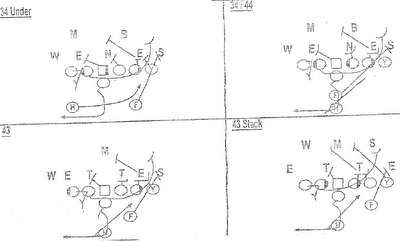The 49ers hit Red Zone pay-dirt on Monday Night Football by running the ball in with Frank Gore for their second touchdown of the evening. The play that they employed from the Steelers’ 5 yard line on 2nd and goal was “F-Counter”.
This play differs from the traditional GT-Counter where the backside Guard and Tackle pull, kick-out and lead – as it features traditional Power-O blocking assignments for the offensive front. If you’ve watched the 49ers much this year (or Jim Harbaugh’s offense at Stanford) you know that they like to run Power-O. The advantage of running F-Counter, as opposed to GT-Counter, is two-fold: 1) everyone else on the offense essentially blocks their bread-and-butter play – Power-O and 2) it is a quicker hitting misdirection play then traditional GT-Counter.
Notice the differences in basic assignments for the three run plays:
 As you can see, there are a few more moving parts to the GT-Counter scheme. Not only do both the back-side Guard and Tackle have to pull, but the Fullback must cutoff any penetration coming off of the pullers’ departure. This adds for a nice element of misdirection, however, it is a difficult scheme to perfect if it is not part of your core philosophy, a-la Joe Gibbs and the Counter Trey.
As you can see, there are a few more moving parts to the GT-Counter scheme. Not only do both the back-side Guard and Tackle have to pull, but the Fullback must cutoff any penetration coming off of the pullers’ departure. This adds for a nice element of misdirection, however, it is a difficult scheme to perfect if it is not part of your core philosophy, a-la Joe Gibbs and the Counter Trey.
By simply switching assignments on their go-to play – the Power-O – between the back-side Guard and Fullback, the 49ers get a quicker hitting misdirection play that is relatively cheap for them to practice.
I have also heard Coach Harbaugh refer to this as their “wrap” play, after they used the same scheme for a 17 yard TD run to extend their lead in the 4th quarter, in a hard fought battle, against the New York Giants.
In the 49ers offense, “wrap” may very well be a term that they tag onto their basic Power-O play. For instance, they may call their base play with a number, i.e. 16-Power. To run the misdirection play with similar Power-O blocking, they can simply replace power with wrap, i.e. 16-Wrap. The number tells everyone else that they are blocking 16 (Power) and the “wrap” tells the Fullback and back-side Guard to switch responsibilities.
To view Gore’s 5 yard TD run against the Steelers, click here.
Below is what the 49ers offensive front saw before the snap on Gore’s score. The Steelers defensive front called for Left Tackle, Adam Snyder, and Left Guard, Mike Iupati, to double team the defensive lineman lined up over Iupati. Snyder’s job is to drive the defensive lineman down the line as Iupati works through him vertically, ready to come off and block the back-side inside linebacker. Center, Jonathan Goodwin blocks back on the defensive nose tackle and Right Guard, Alex Boone, pulls with a tight path, looking to kick out the first man showing up off of Staley’s down block. Fullback, Bruce Miller, delays to allow Boone and quarterback, Alex Smith, to clear before he comes back across the formation and leads through to block the front-side inside linebacker. Anthony Davis and Vernon Davis cutoff any penetration from the back-side.
This is what the pre-snap assignments look like:
If you watch the play closely, you will notice that neither Iupati nor Miller get to their initial blocking assignment. In fact, right before the snap the play-side inside linebacker blitzed the (A) gap to Iupati’s right.
Often, with younger offensive linemen, this is problematic to the double team. If the inside man on the double team fails to anticipate an A-gap stunt or blitz, and stays on his double team, the play will undoubtedly be blown up in the backfield.
However, through film study and practice repetition, Iupati knew to have his eyes up and to be alert for “front-side run through”. He was able to easily ignore the double team and execute a down block on the blitzing linebacker. Snyder and Iupati were most likely very aware of this possibility (based on the above factors) and probably had some kind of communication in place to inform Snyder that he would have to secure the down block on Iupati’s man without help from Iupati.
Fullback, Bruce Miller, may have had a call echoed to him by the offensive line to alert him to the switch. It is more likely, however, that he executed his block based on visual cues and stimulus response conditioning. That is: he was ready for either scenario – like Iupati and Snyder – after numerous repetitions on the practice field (along with film study) working on turning up and blocking the first wrong color from the inside-out.
Notice the assignment change for Iupati and Miller as they recognize front-side run through:
Seeing how this play has paid dividends more then a couple times (click here to view Kendall Hunter’s run against the Giants), I would look for it again when the 49ers get into the red zone … or more so when teams are selling out at the point of attack to stop their bread-and-butter play, the Power-O.








